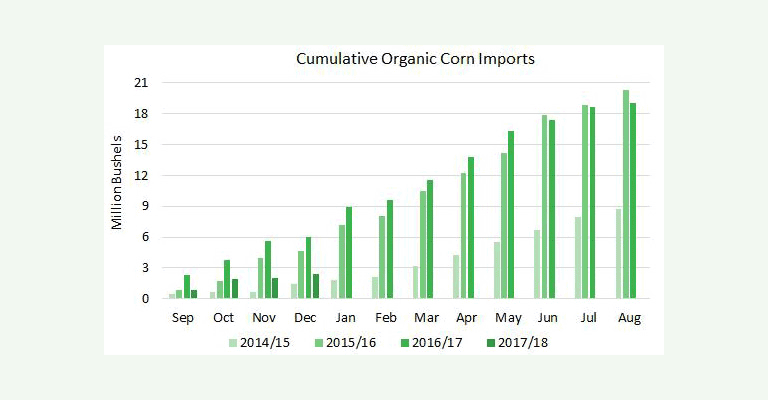By Rachel Storey and Ryan Koory, Mercaris
Last year was a newsworthy one for organics. Two major topics of interest were 1) high proportion of organic imports compared to domestically-produced commodities (in the 2016/2017 marketing year, about 78 percent of organic soy and 41 percent of organic corn were imported, per Mercaris data), and 2) questionable “organic” imports, an important topic covered by the Washington Post. In short, 2017 was the year we were made painfully aware that, despite significant progress, the U.S. still has a long way to go in boosting organic production and building adequate organic infrastructure.
Interestingly, as soon as we really started talking about organic imports, year-over-year corn import volumes began a decline that has continued through at least the first four months of the 2017/2018 marketing year. Import volumes are likely to pick up over this quarter and into the third quarter, but the pace of imports is likely to remain slowed on a year-over-year basis.
While this trend could be haphazardly attributed to decreased demand for foreign organic grains due to the Post’s good investigative work, we hesitate to equate correlation with causation. Our data indicates that 2017/2018 saw 35 percent more domestic organic corn production than 2016/2017, meaning imports of corn will necessarily decrease as a simple matter of supply and demand. Mercaris finds it unlikely that US organic corn imports will reach the levels reached in 2016/2017 (approximately 19 million bushels), and we’re hoping the trend of increased domestic organic production continues.
On the other hand, organic soybean imports in 2017 were up 28 percent year-over-year through December 2017. While organic corn demand will increasingly be met domestically, US soybean imports appear to remain supported by expanding demand for animal feed, protein-added packaged goods, and plant-based protein substitutes. So far, organic soybean imports seem to be on a certain path to surpass 2016/17 import levels. We cannot forecast actual numbers at this time, but total 2017/2018 organic soybean imports will be driven by 1) the growth rate of US livestock production, and 2) foreign organic soybean supplies. Imports will continue to rise in the immediate term and until demand levels out and domestic organic soy supply begins to catch up to that demand.
While we continue to be optimistic about increases in domestic organic production, we need to ensure that in the meantime 1) organic imports meet organic standards and 2) we continue to provide tools and resources to help more farmers transition their crops to organic.
We’d love to hear your ideas for ways to improve domestic availability of organic grains—email us at mercaris@mercaris.com or Tweet to us @mercaris!









